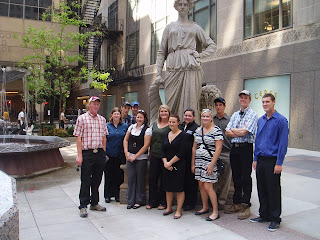Today we toured the Chicago Board of Trade, or as it is called today the CME Group (Chicago Mercantile Exchange Group). The C.B.O.T. was established in 1848, and today is the largest trading center in the world. Commodities such as corn, wheat, and soybeans are traded here. Also the livestock and financial markets operate out of the C.B.O.T. There are two trading floors based in Chicago, and the other is based in New York. In Chicago, there is the grain and energies floor, and the finance and livestock floor.
As technology advances, more and more of the trading is done on a system called Globex. This is an easy way for CME group members to access the markets and make trades without having to physically be on the trade floor. This was first introduced in the late 80’s and early 90’s, but did not become overly popular until 2003. Today the trading floors are a lot more “tame”, then in the past. This is due to the advancement in technology, allowing for electronic trades to occur. Today 85% of the futures contracts and 75% of the options contracts are traded using Globex.
When over looking the floor, it looks like a world of its own. There is a certain dress code, and what appears to be a whole new language. Different colour coats are worn to represent various positions on the floor. Speculators wear many different patterns in order to stand out among the crowd. Different brokers wear different colours, depending on the companies they work for. There are also clerks out on the floors that overlook all the trades and enter them into the system once they are traded. These people wear blue coats and are employees of the CME group.
There are certain signals used along with the open outcry system. It is impossible to learn them all just by a 45 minute tour but there are some basic ones our tour guide mentioned. Whether you face your palm towards your body or away from your body determines if you are selling or buying a contract. To determine how many contracts you are selling you can hold up 1,2,3, fingers and so on. Different positions on your body represent increases in “zeros”. For example on your chin, 1 finger is 10 contracts. One finger behind your head is 1000. Grain commodity contracts are 5000 bushels in size, whereas livestock contracts are 40,000 lbs. per contract.
The Chicago Board of Trade is a highly secure building. To enter the building you must go through a security check, similar to one at the airport. They practice fire drills periodically to ensure that everyone knows where to exit the building. The C.B.O.T. has twelve sources of power, so it is highly unlikely that it would ever be affected by a power outage. These precautions must be taken because this is the center for a lot of valuable information. This is the place that keeps the world markets running, and the world markets would be greatly affected if this information were altered in any way.
In forty-five minutes we had a very quick overview of what goes on at the CME group, but there is a lot more to learn. To understand the “ins and outs” of this organization it is almost as though you would have to be a part of it. It was a little overwhelming to think that the trading floors we were overlooking are where the commodity prices are determined. It is interesting to think that everything that is determined on those floors effects all of us one way or another, from selling our own crops to buying our cornflakes for breakfast. All in all this way was an interesting tour and we all enjoyed immensely.
Hilary Duenk



